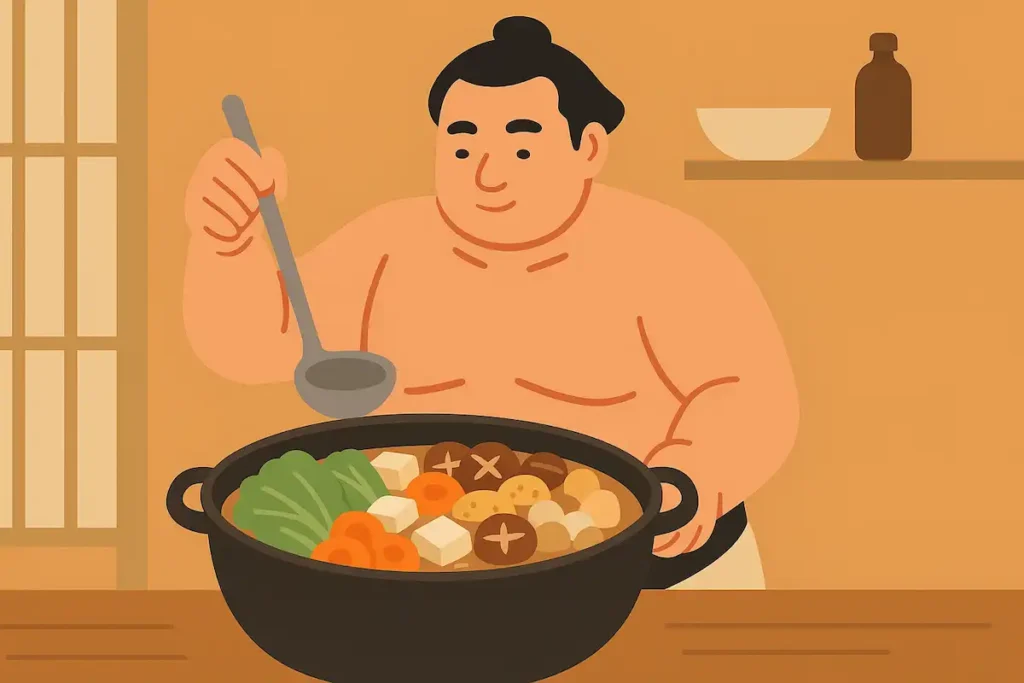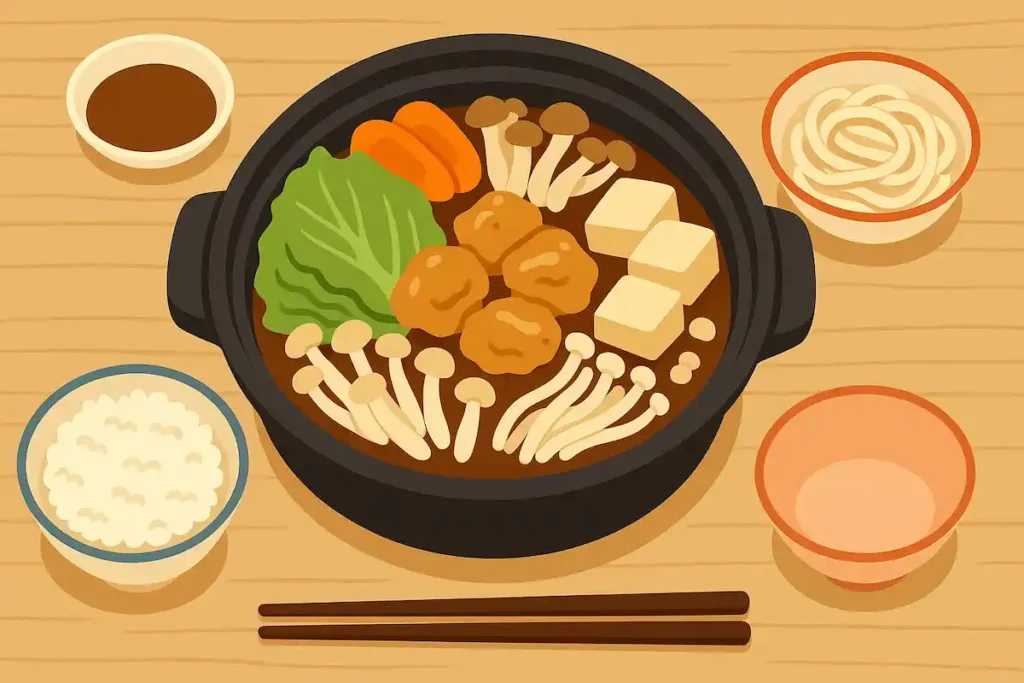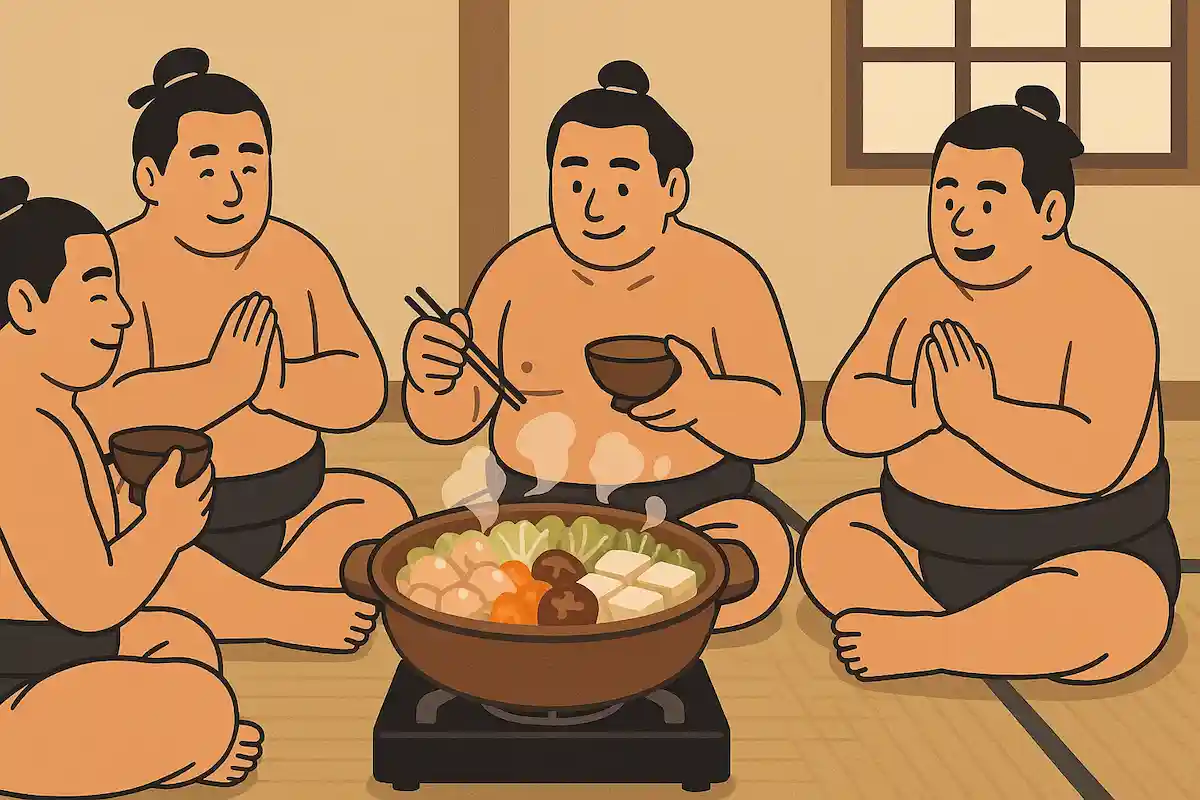ちゃんこ鍋を英語で説明・紹介するための基本情報と、英会話に役立つ表現をシンプルでわかりやすい英語で紹介します。
英会話ダイアローグ・概要・10の質問を通して、ちゃんこ鍋に関する英語表現を学びます。
英語
英会話ダイアローグを読む前に知っておくと良い前提知識と情報です。
- ちゃんこ鍋の基本
- 相撲部屋で力士が食べる鍋料理、もともと「ちゃんこ」とは相撲部屋の食事全般を意味
- 具材は、鶏肉・魚・肉団子・豆腐・野菜を中心に栄養満点
- しょうゆ、みそ、塩、キムチ風などさまざまで、相撲部屋ごとに秘伝の味がある
- 相撲との関わり
- 明治時代から相撲部屋で食べられてきた伝統料理鶏肉が「二本足で立つ=倒れない」という意味から、勝負に強くなる象徴として好まれる
- 力士が「ちゃんこ番」として順番に作り、食を通じて部屋の絆を深める
- 栄養と魅力
- タンパク質・野菜のビタミン・食物繊維・シメの炭水化物まで、1つの鍋でバランス良く摂れる
- 健康的、飽きないバリエーション、みんなで食べる一体感が魅力
- 現代の人気と観光性
- 一般家庭でも冬の定番鍋として親しまれている
- 両国は相撲の聖地で、国技館周辺には多くのちゃんこ鍋専門店があり、観光スポットとしても人気
2人がちゃんこ鍋について話しています。
相撲文化・力士とのつながり、栄養豊富な具材の組み合わせ、鍋を囲む連帯感などを話題にしています。
会話 / dialogue

Hey Key, I’ve been hearing a lot about chanko nabe recently. Do you know much about it?

Of course! It’s one of Japan’s most famous hot pot dishes, especially connected to sumo wrestlers.

Oh, really? I thought it was just another type of hot pot like sukiyaki or shabu-shabu.

It’s similar, but special. In fact, “chanko” originally meant all meals in a sumo stable. But now most people think of this hot pot when they hear the word.

Interesting! So what makes it different from other hot pots?

First, it’s packed with nutrition. It usually has chicken, fish, tofu, and lots of vegetables like cabbage, carrots, and mushrooms.

Sounds healthy. Why is chicken used so often?

There’s a symbolic reason. Chickens stand on two legs, so wrestlers believe it means “not to fall down.” It’s a lucky choice.

That’s a fun detail. Are the flavors always the same?

Not at all. The soup can be soy sauce, miso, salt, or even kimchi style. Each sumo stable has its own secret recipe.

Wow, so it’s really diverse. I guess wrestlers eat it to get strong?

Exactly. They eat huge amounts after training. Chanko nabe is almost like a complete meal: protein from meat, vitamins from vegetables, and carbohydrates at the end with rice or noodles.

So they even add rice or noodles at the end? That sounds delicious.

Yes, it’s the highlight! Many people love finishing with zosui (rice porridge) or udon.

I can see why it’s amazing. It’s healthy, filling, and flexible.

And don’t forget the charm of eating together. Everyone gathers around one big pot, which creates a warm and friendly atmosphere.

That makes sense. Eating from the same pot brings people closer.

Exactly. That’s one reason it’s so popular, not just with wrestlers but with families and tourists too.

Speaking of tourists, do visitors to Japan get a chance to try it?

Definitely! In Ryogoku, Tokyo, there are many restaurants that serve authentic chanko nabe. Tourists often eat it after watching sumo.

That must be a great cultural experience – food and sumo together.

Yes, it’s both tasty and cultural. Many visitors say it’s one of the highlights of their trip.

Now I really want to try it myself. Have you eaten it at a restaurant?

Yes, a few times in Ryogoku. The portions are big, so it’s best to go with friends.

Perfect, then let’s plan to go together. I want to experience the real taste of chanko nabe.

Great idea! You’ll enjoy both the flavor and the atmosphere.
概要(ちゃんこ鍋の魅力と相撲文化)
「ちゃんこ鍋」について、理解を深めるための「英語での概要」です。
ちゃんこ鍋

What is Chanko Nabe?
Chanko nabe is a special Japanese hot pot that is strongly connected to sumo wrestling. The word “chanko” first meant all meals served in a sumo stable, but today most people think of this hearty hot pot. It is one of the most famous dishes in Japan, loved for being healthy, filling, and social.
Ingredients and Nutrition
The hot pot usually includes chicken, fish, tofu, and a large variety of vegetables such as cabbage, carrots, mushrooms, and green onions. Chicken is often chosen because it stands on two legs, which wrestlers see as good luck. The dish is very healthy because it combines protein, vitamins, fiber, and at the end, carbohydrates when rice or noodles are added. This makes it a complete and balanced meal.
Tastes and Variations
Chanko nabe has many different flavors. The soup base can be soy sauce, miso, salt, or even spicy kimchi style. Each sumo stable has its own secret recipe, so the taste can be unique. Because of this flexibility, people never get tired of it, and families can easily cook it at home in many ways.
Cultural Experience and Popularity
Eating chanko nabe is also a social experience. Everyone gathers around one big pot, which creates a warm and friendly atmosphere. Today, chanko nabe is popular not only with wrestlers but also with families and tourists. In Ryogoku, Tokyo, there are many restaurants where visitors can enjoy authentic chanko nabe, often after watching sumo. For many tourists, it is both a delicious meal and a special way to experience Japanese culture.
10の質問(ちゃんこ鍋の基本知識)
「ちゃんこ鍋」について、理解を深めるための「英語での10の質問」です。
1: What is Chanko Nabe?
Chanko Nabe is a Japanese hot pot dish that is closely connected to sumo wrestlers. It is famous for being healthy and filling.
2: Why do sumo wrestlers eat Chanko Nabe?
They eat it to build strength and gain weight. It provides a lot of nutrition after training.
3: What ingredients are used in Chanko Nabe?
It usually has chicken, fish, tofu, and many vegetables such as cabbage, carrots, mushrooms, and green onions.
4: Why is chicken often used in Chanko Nabe?
Chicken stands on two legs, which is seen as good luck for wrestlers. It means “not to fall down.”
5: What are the common soup flavors of Chanko Nabe?
The soup can be soy sauce, miso, salt, or even spicy kimchi style.
6: Do all sumo stables cook Chanko Nabe the same way?
No, each stable has its own secret recipe, so the flavors and ingredients can be different.
7: How do people usually finish the meal?
They add rice to make porridge or put noodles into the remaining soup at the end.
8: Is Chanko Nabe popular outside of sumo stables?
Yes, families cook it at home, and many restaurants in Japan serve it, especially in Tokyo’s Ryogoku area.
9: Why is Chanko Nabe considered healthy?
It has protein from meat and fish, vitamins from vegetables, and carbohydrates from rice or noodles, making it a balanced meal.
10: Can tourists try Chanko Nabe in Japan?
Yes, tourists can enjoy authentic Chanko Nabe at restaurants, often after watching sumo in Ryogoku, Tokyo.

和訳付
会話 / dialogue

Hey Key, I’ve been hearing a lot about chanko nabe recently. Do you know much about it?
ねえキー、最近「ちゃんこ鍋」の話をよく聞くんだけど、詳しい?

Of course! It’s one of Japan’s most famous hot pot dishes, especially connected to sumo wrestlers.
もちろん!日本で有名な鍋料理の一つで、特に相撲と深く関わっているんだ。

Oh, really? I thought it was just another type of hot pot like sukiyaki or shabu-shabu.
へえ、そうなんだ?すき焼きとかしゃぶしゃぶみたいな鍋料理の一つだと思ってたよ。

It’s similar, but special. In fact, “chanko” originally meant all meals in a sumo stable. But now most people think of this hot pot when they hear the word.
似てるけど特別なんだよ。もともと「ちゃんこ」って相撲部屋で出される食事全般を指してたんだ。でも今では、鍋料理のことを思い浮かべる人が多いね。

Interesting! So what makes it different from other hot pots?
面白いね!じゃあ他の鍋と何が違うの?

First, it’s packed with nutrition. It usually has chicken, fish, tofu, and lots of vegetables like cabbage, carrots, and mushrooms.
まず栄養満点なところ。鶏肉や魚、豆腐、それにキャベツやにんじん、きのこ類なんか野菜もたっぷり入るんだ。

Sounds healthy. Why is chicken used so often?
すごく健康的そうだね。鶏肉がよく使われるのはなんで?

There’s a symbolic reason. Chickens stand on two legs, so wrestlers believe it means “not to fall down.” It’s a lucky choice.
縁起をかついでるんだよ。鶏は二本足で立つから「四つん這いにならない=負けない」ってことで、幸運の象徴なんだ。

That’s a fun detail. Are the flavors always the same?
なるほど、それ面白いね。味付けはいつも同じなの?

Not at all. The soup can be soy sauce, miso, salt, or even kimchi style. Each sumo stable has its own secret recipe.
全然違うよ。スープは醤油味だったり、味噌や塩、キムチ風なんかもあるし、相撲部屋ごとに秘伝のレシピがあるんだ。

Wow, so it’s really diverse. I guess wrestlers eat it to get strong?
へえ、すごくバリエーションがあるんだね。力士は体を大きくするために食べるのかな?

Exactly. They eat huge amounts after training. Chanko nabe is almost like a complete meal: protein from meat, vitamins from vegetables, and carbohydrates at the end with rice or noodles.
その通り。稽古のあとに大量に食べるんだ。肉でたんぱく質、野菜でビタミン、最後にご飯や麺で炭水化物をとれて、ほぼ完全食なんだよ。

So they even add rice or noodles at the end? That sounds delicious.
最後にご飯とか麺まで入れるの?それ絶対美味しいじゃん。

Yes, it’s the highlight! Many people love finishing with zosui (rice porridge) or udon.
そう、それが楽しみのひとつ!雑炊にしたり、うどんを入れるのが人気だよ。

I can see why it’s amazing. It’s healthy, filling, and flexible.
なるほど、すごい理由が分かったよ。健康的で、ボリュームがあって、しかもアレンジ自在なんだね。

And don’t forget the charm of eating together. Everyone gathers around one big pot, which creates a warm and friendly atmosphere.
それに「みんなで食べる楽しさ」も忘れちゃだめだよ。大きな鍋を囲むから、あったかくていい雰囲気になるんだ。

That makes sense. Eating from the same pot brings people closer.
確かに。ひとつの鍋をみんなでつつくと仲良くなれるよね。

Exactly. That’s one reason it’s so popular, not just with wrestlers but with families and tourists too.
そうそう。それが人気の理由の一つで、力士だけじゃなく、家庭や観光客にも愛されてるんだ。

Speaking of tourists, do visitors to Japan get a chance to try it?
観光客も食べられるの?

Definitely! In Ryogoku, Tokyo, there are many restaurants that serve authentic chanko nabe. Tourists often eat it after watching sumo.
もちろん!東京の両国には本格的なちゃんこ鍋を出す店がたくさんあって、観光客は相撲観戦のあとに食べたりするんだ。

That must be a great cultural experience – food and sumo together.
それって最高の文化体験だね。食と相撲を一緒に楽しめるなんて。

Yes, it’s both tasty and cultural. Many visitors say it’s one of the highlights of their trip.
うん、美味しいだけじゃなく文化的でもあるからね。旅行のハイライトだって言う人も多いよ。

Now I really want to try it myself. Have you eaten it at a restaurant?
なんか、ますます食べたくなってきた!キーはお店で食べたことある?

Yes, a few times in Ryogoku. The portions are big, so it’s best to go with friends.
あるよ、両国で何度か。量が多いから友達と一緒に行くのがいいね。

Perfect, then let’s plan to go together. I want to experience the real taste of chanko nabe.
じゃあ今度一緒に行こうよ!本場のちゃんこ鍋を体験したいんだ。

Great idea! You’ll enjoy both the flavor and the atmosphere.
いいね!味も雰囲気も楽しめるはずだよ。
概要(ちゃんこ鍋の魅力と相撲文化)
ちゃんこ鍋

What is Chanko Nabe?
Chanko nabe is a special Japanese hot pot that is strongly connected to sumo wrestling. The word “chanko” first meant all meals served in a sumo stable, but today most people think of this hearty hot pot. It is one of the most famous dishes in Japan, loved for being healthy, filling, and social.
ちゃんこ鍋とは?
ちゃんこ鍋は、相撲と深く結びついた特別な日本の鍋料理です。もともと「ちゃんこ」という言葉は相撲部屋で出される食事全般を意味していましたが、今では多くの人がこのボリュームたっぷりの鍋を思い浮かべます。日本で最も有名な料理の一つで、健康的で、お腹いっぱいになり、みんなで楽しめる料理として愛されています。
Ingredients and Nutrition
The hot pot usually includes chicken, fish, tofu, and a large variety of vegetables such as cabbage, carrots, mushrooms, and green onions. Chicken is often chosen because it stands on two legs, which wrestlers see as good luck. The dish is very healthy because it combines protein, vitamins, fiber, and at the end, carbohydrates when rice or noodles are added. This makes it a complete and balanced meal.
材料と栄養
ちゃんこ鍋には、鶏肉、魚、豆腐、キャベツ・にんじん・きのこ・ネギなどの多くの野菜が入ります。鶏肉がよく使われるのは、二本足で立つため「縁起が良い」と力士に考えられているからです。肉からのタンパク質、野菜からのビタミンや食物繊維、そして最後にご飯や麺を入れることで炭水化物も加わり、とても健康的で栄養バランスの整った食事になります。
Tastes and Variations
Chanko nabe has many different flavors. The soup base can be soy sauce, miso, salt, or even spicy kimchi style. Each sumo stable has its own secret recipe, so the taste can be unique. Because of this flexibility, people never get tired of it, and families can easily cook it at home in many ways.
味とバリエーション
ちゃんこ鍋にはさまざまな味があります。スープのベースは、しょうゆ、みそ、塩、あるいはピリ辛のキムチ風など多彩です。相撲部屋ごとに秘伝のレシピがあり、味わいは独自のものになります。この柔軟さのおかげで飽きることがなく、家庭でもいろいろなスタイルで気軽に作ることができます。
Cultural Experience and Popularity
Eating chanko nabe is also a social experience. Everyone gathers around one big pot, which creates a warm and friendly atmosphere. Today, chanko nabe is popular not only with wrestlers but also with families and tourists. In Ryogoku, Tokyo, there are many restaurants where visitors can enjoy authentic chanko nabe, often after watching sumo. For many tourists, it is both a delicious meal and a special way to experience Japanese culture.
文化体験と人気
ちゃんこ鍋を食べることは、社交的な体験でもあります。みんなで大きな鍋を囲むことで、温かく親しみやすい雰囲気が生まれます。現在では、力士だけでなく家庭や観光客にも人気があります。東京の両国には本格的なちゃんこ鍋を楽しめる店が多く、相撲観戦の後に食べる観光客も多いです。多くの旅行者にとって、ちゃんこ鍋は美味しい食事であると同時に、日本文化を体験できる特別な方法でもあります。
10の質問(ちゃんこ鍋の基本知識)
1: What is Chanko Nabe?
ちゃんこ鍋とは何ですか?
Chanko Nabe is a Japanese hot pot dish that is closely connected to sumo wrestlers. It is famous for being healthy and filling.
ちゃんこ鍋は相撲と深く結びついた日本の鍋料理です。健康的でボリュームがあることで有名です。
2: Why do sumo wrestlers eat Chanko Nabe?
なぜ力士はちゃんこ鍋を食べるのですか?
They eat it to build strength and gain weight. It provides a lot of nutrition after training.
力士は体力をつけ、体重を増やすために食べます。稽古の後に多くの栄養を補給できます。
3: What ingredients are used in Chanko Nabe?
ちゃんこ鍋にはどんな材料が使われますか?
It usually has chicken, fish, tofu, and many vegetables such as cabbage, carrots, mushrooms, and green onions.
一般的に鶏肉、魚、豆腐、そしてキャベツ、にんじん、きのこ、ネギなど多くの野菜が入ります。
4: Why is chicken often used in Chanko Nabe?
なぜ鶏肉がよく使われるのですか?
Chicken stands on two legs, which is seen as good luck for wrestlers. It means “not to fall down.”
鶏は二本足で立つため、力士にとって縁起が良いとされます。「倒れない」という意味があります。
5: What are the common soup flavors of Chanko Nabe?
ちゃんこ鍋の一般的なスープの味は何ですか?
The soup can be soy sauce, miso, salt, or even spicy kimchi style.
スープはしょうゆ、みそ、塩、またはピリ辛のキムチ風などがあります。
6: Do all sumo stables cook Chanko Nabe the same way?
全ての相撲部屋で同じ作り方をするのですか?
No, each stable has its own secret recipe, so the flavors and ingredients can be different.
いいえ、相撲部屋ごとに秘伝のレシピがあり、味や具材は異なります。
7: How do people usually finish the meal?
食事の最後はどうやって締めますか?
They add rice to make porridge or put noodles into the remaining soup at the end.
残ったスープにご飯を入れて雑炊にしたり、麺を入れることが多いです。
8: Is Chanko Nabe popular outside of sumo stables?
相撲部屋以外でもちゃんこ鍋は人気ですか?
Yes, families cook it at home, and many restaurants in Japan serve it, especially in Tokyo’s Ryogoku area.
はい、家庭でも作られますし、日本の多くの店で提供されています。特に東京の両国では有名です。
9: Why is Chanko Nabe considered healthy?
なぜちゃんこ鍋は健康的とされるのですか?
It has protein from meat and fish, vitamins from vegetables, and carbohydrates from rice or noodles, making it a balanced meal.
肉や魚からのタンパク質、野菜からのビタミン、ご飯や麺からの炭水化物を含み、バランスの良い食事になるからです。
10: Can tourists try Chanko Nabe in Japan?
観光客は日本でちゃんこ鍋を食べられますか?
Yes, tourists can enjoy authentic Chanko Nabe at restaurants, often after watching sumo in Ryogoku, Tokyo.
はい、観光客は東京・両国の店などで本格的なちゃんこ鍋を楽しめ、相撲観戦の後に食べることも多いです。

words & phrases
英会話ダイアローグと関連情報に出てきた単語・フレーズです(例文は各3つ)。

packed : 形容詞 /pækt/
意味: 詰まっている、ぎっしり入っている。Full of things or people; very crowded or full.
(ちゃんこ鍋が栄養で「ぎっしり詰まっている」ことを表す)
例文:
- The train was packed with passengers during rush hour.
「ラッシュアワーには電車は乗客でいっぱいでした。」 - This dish is packed with flavors and spices.
「この料理は風味とスパイスがぎっしり詰まっています。」 - Chanko nabe is packed with nutrition.
「ちゃんこ鍋は栄養でいっぱいです。」
nutrition : 名詞 /njuːˈtrɪʃ.ən/
意味: 栄養、栄養学。The process of getting the food necessary for health and growth.
(ちゃんこ鍋が稽古後の力士に「栄養を与える」料理であることを説明)
例文:
- Good nutrition is important for children’s growth.
「良い栄養は子どもの成長に大切です。」 - The doctor gave advice on nutrition and exercise.
「医師は栄養と運動について助言しました。」 - Wrestlers eat chanko nabe for strong nutrition.
「力士は強い栄養のためにちゃんこ鍋を食べます。」
carbohydrate : 名詞 /ˌkɑːr.bəʊˈhaɪ.dreɪt/
意味: 炭水化物。A substance in food such as sugar, rice, or bread that gives energy.
(ちゃんこ鍋の「ご飯や麺」で補う炭水化物を説明)
例文:
- Bread and rice are rich in carbohydrates.
「パンやご飯は炭水化物が豊富です。」 - Athletes need a lot of carbohydrates for energy.
「アスリートはエネルギーのために多くの炭水化物が必要です。」 - The noodles in chanko nabe provide carbohydrates.
「ちゃんこ鍋の麺は炭水化物を補給します。」
filling : 形容詞 /ˈfɪl.ɪŋ/
意味: 満腹感を与える。Food that makes you feel full.
(ちゃんこ鍋が「食べごたえがあり、お腹いっぱいになる」料理であることを表現)
例文:
- The soup was light but very filling.
「そのスープはあっさりしていたけれど、とてもお腹がいっぱいになりました。」 - Sandwiches are simple and filling.
「サンドイッチはシンプルで満腹感があります。」 - Chanko nabe is a healthy and filling hot pot.
「ちゃんこ鍋は健康的でお腹いっぱいになる鍋料理です。」
flexible : 形容詞 /ˈflek.sə.bəl/
意味: 柔軟な、融通がきく。Able to change or be adapted easily.
(ちゃんこ鍋は具材や味を自由に変えられる「柔軟さ」が魅力であることを説明)
例文:
- She has a flexible schedule, so she can meet anytime.
「彼女は予定が柔軟なので、いつでも会うことができます。」 - This job needs someone who is flexible and creative.
「この仕事には柔軟で創造的な人が必要です。」 - Chanko nabe is flexible, because you can change the soup and ingredients.
「ちゃんこ鍋は柔軟で、スープや具材を自由に変えられます。」
詳細情報 / Further Info
関連記事(相撲)

